The ASRock X99E-ITX/ac Review: Up to 36 Threads in Mini-ITX
by Ian Cutress on June 24, 2015 8:00 AM ESTGaming Performance 2015
Our 2015 gaming results are still relatively new, and thus along with the motherboards tested we are also including some other CPU results for completeness.
Alien: Isolation
If first person survival mixed with horror is your sort of thing, then Alien: Isolation, based off of the Alien franchise, should be an interesting title. Developed by The Creative Assembly and released in October 2014, Alien: Isolation has won numerous awards from Game Of The Year to several top 10s/25s and Best Horror titles, ratcheting up over a million sales by February 2015. Alien: Isolation uses a custom built engine which includes dynamic sound effects and should be fully multi-core enabled.
For low end graphics, we test at 720p with Ultra settings, whereas for mid and high range graphics we bump this up to 1080p, taking the average frame rate as our marker with a scripted version of the built-in benchmark.


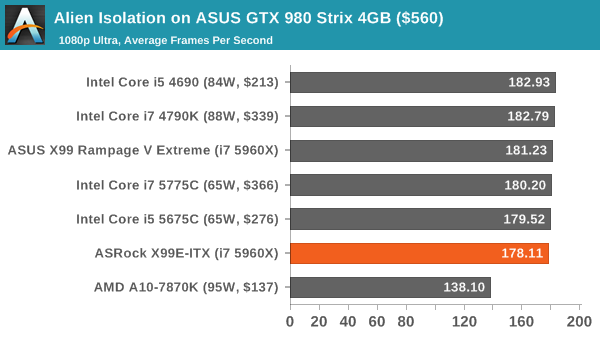
Total War: Attila
The Total War franchise moves on to Attila, another The Creative Assembly development, and is a stand-alone strategy title set in 395AD where the main story line lets the gamer take control of the leader of the Huns in order to conquer parts of the world. Graphically the game can render hundreds/thousands of units on screen at once, all with their individual actions and can put some of the big cards to task.
For low end graphics, we test at 720p with performance settings, recording the average frame rate. With mid and high range graphics, we test at 1080p with the quality setting. In both circumstances, unlimited video memory is enabled and the in-game scripted benchmark is used.
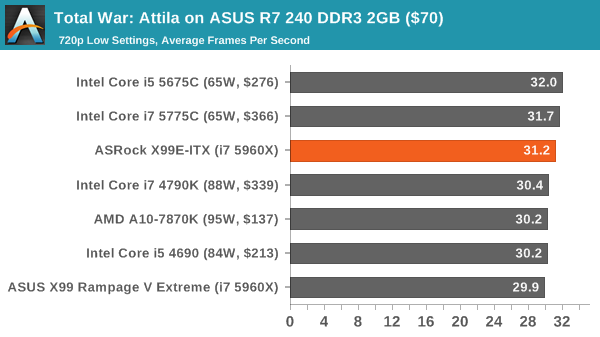
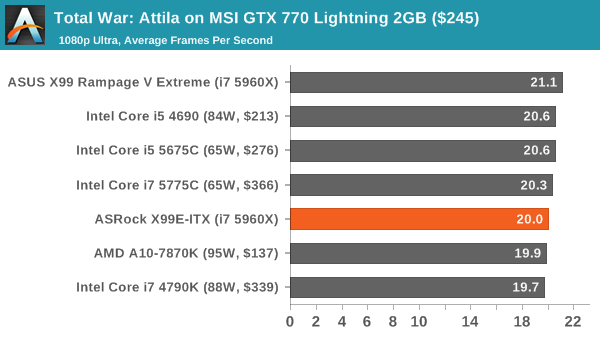
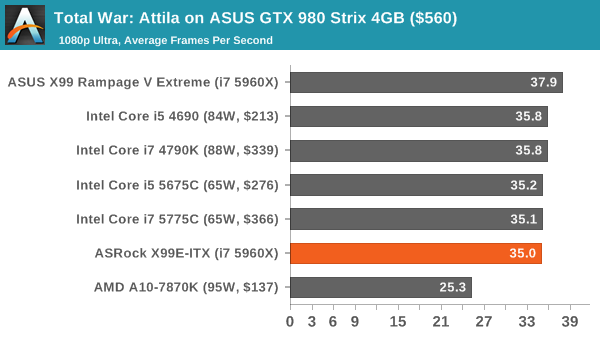
Grand Theft Auto V
The highly anticipated iteration of the Grand Theft Auto franchise finally hit the shelves on April 14th 2015, with both AMD and NVIDIA in tow to help optimize the title. GTA doesn’t provide graphical presets, but opens up the options to users and extends the boundaries by pushing even the hardest systems to the limit using Rockstar’s Advanced Game Engine. Whether the user is flying high in the mountains with long draw distances or dealing with assorted trash in the city, when cranked up to maximum it creates stunning visuals but hard work for both the CPU and the GPU.
For our test we have scripted a version of the in-game benchmark, relying only on the final part which combines a flight scene along with an in-city drive-by followed by a tanker explosion. For low end systems we test at 720p on the lowest settings, whereas mid and high end graphics play at 1080p with very high settings across the board. We record both the average frame rate and the percentage of frames under 60 FPS (16.6ms).
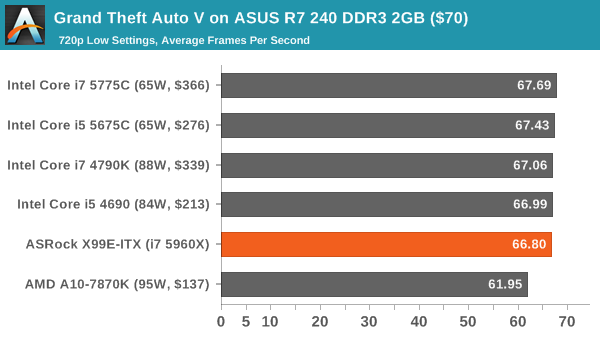
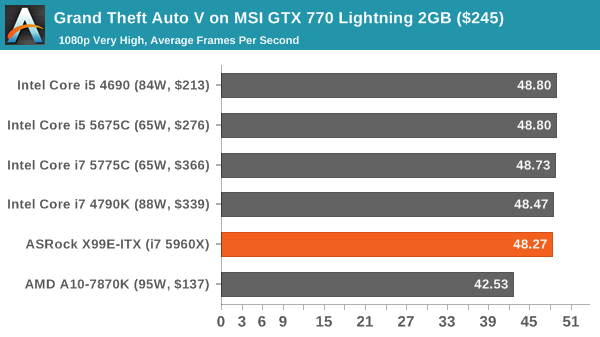
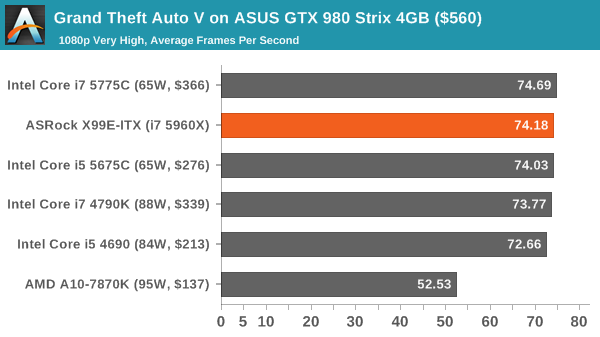
GRID: Autosport
No graphics tests are complete without some input from Codemasters and the EGO engine, which means for this round of testing we point towards GRID: Autosport, the next iteration in the GRID and racing genre. As with our previous racing testing, each update to the engine aims to add in effects, reflections, detail and realism, with Codemasters making ‘authenticity’ a main focal point for this version.
GRID’s benchmark mode is very flexible, and as a result we created a test race using a shortened version of the Red Bull Ring with twelve cars doing two laps. The car is focus starts last and is quite fast, but usually finishes second or third. For low end graphics we test at 1080p medium settings, whereas mid and high end graphics get the full 1080p maximum. Both the average and minimum frame rates are recorded.
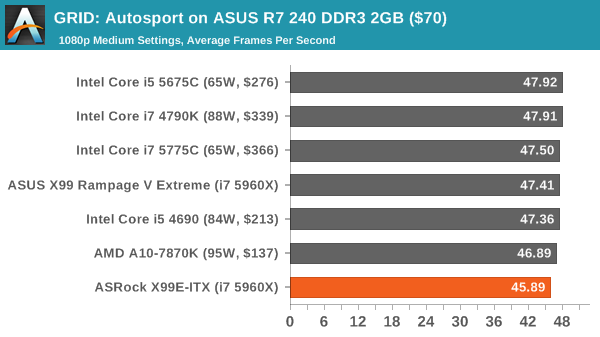
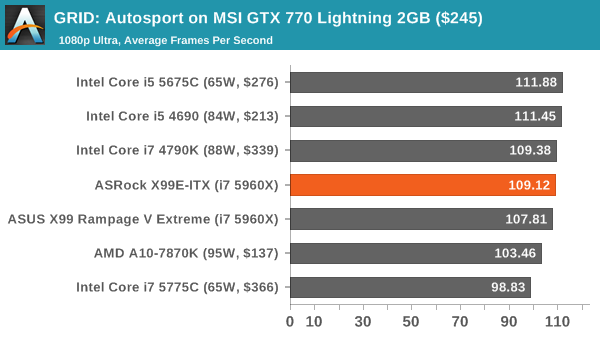
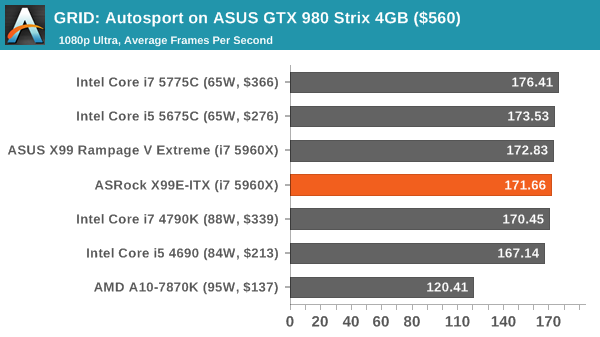
Middle-Earth: Shadows of Mordor
The final title in our testing is another battle of system performance with the open world action-adventure title, Shadows of Mordor. Produced by Monolith using the LithTech Jupiter EX engine and numerous detail add-ons, SoM goes for detail and complexity to a large extent, despite having to be cut down from the original plans. The main story itself was written by the same writer as Red Dead Redemption, and it received Zero Punctuation’s Game of The Year in 2014.
For testing purposes, SoM gives a dynamic screen resolution setting, allowing us to render at high resolutions that are then scaled down to the monitor. As a result, we get several tests using the in-game benchmark. For low end graphics we examine at 720p with low settings, whereas mid and high end graphics get 1080p Ultra. The top graphics test is also redone at 3840x2160, also with Ultra settings, and we also test two cards at 4K where possible.
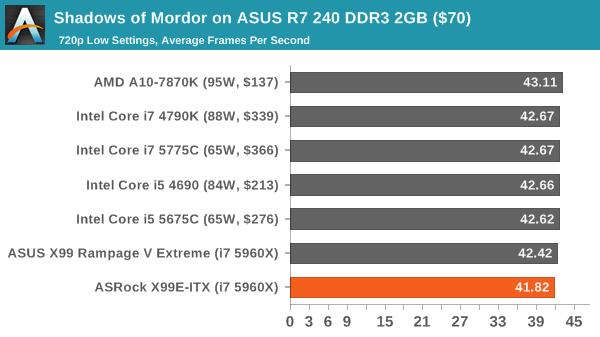
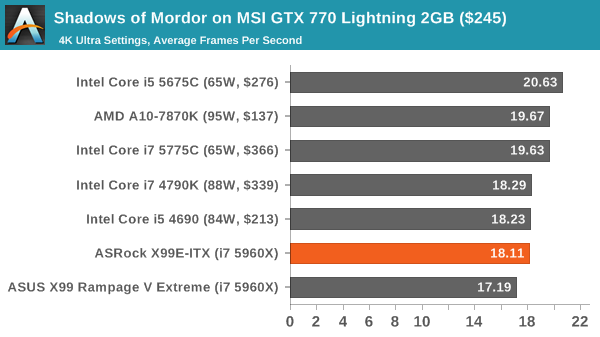
















56 Comments
View All Comments
mobutu - Wednesday, June 24, 2015 - link
"For readers expecting the AMD Fury X review, unfortunately Ryan has been battling a virus this week and despite his best efforts it has taken its toll"lol, this was the same reason given for the missing nvidia 960 review, and then it was next week, then next etc and its like half a year late already ...
1mpetuous - Wednesday, June 24, 2015 - link
If you're too desperate to wait for analysis the raw data is already in Bench.der - Wednesday, June 24, 2015 - link
20th comment.MOAR THREADS MOAR POWER!
bernstein - Wednesday, June 24, 2015 - link
while it might be *cool* to have 18 cores in mITX form, $4500 for such a cpu makes it prohibitively expensive for almost all mITX use-cases, heck even 14 cores at $2750 or 10 at $2000 i mostly just wasting money. these are designed & sold for 2S or 4S configurations!its the E5-16xx v3 cpus that make most sense... so were talking up to 8 cores...
bernstein - Wednesday, June 24, 2015 - link
or a i7-5xx0... but then you loose ECC...MrSpadge - Wednesday, June 24, 2015 - link
I think the 5820K would be best suited for this mainboard, as it relaxes cooling and is going to "suffer" the least from dual channel memory.cyrusfox - Wednesday, June 24, 2015 - link
I don't get it, one of the reasons I would get this platform is for quad channel memory, seems like they could have made this work by using sodimms and doing some inventive layout by allowing half the ram to be attached to the back of the board.DanNeely - Wednesday, June 24, 2015 - link
If they used SoDIMMs an equal number of commenters would be flaming it for being limited to crappy lower performing ram. At present availability might be a problem too. Newegg and Amazon don't appear to have any DDR4 SoDIMMs available; and the only capacity Micron lists as being in production is an 8GB version.yuhong - Wednesday, June 24, 2015 - link
I think there is another server oriented mini ITX X99 board that does that, using DDR4 ECC SO-DIMMs I think. Unfortunately they are more expensive at this point.creed3020 - Monday, June 29, 2015 - link
Look no further than the ASRock RACK EPC612D4I for a mITX board with LGA2011-3 and quad channel memory support.http://www.servethehome.com/asrock-rack-epc612d4i-...